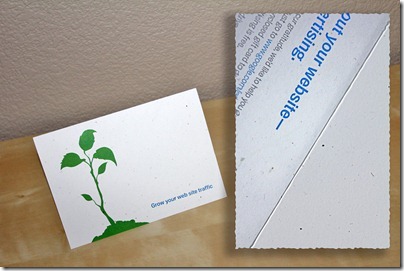Wildflower seed paper
Today I received a promotional mailing from Google, presumably because this blog is hosted by Google’s Blogger service. I almost threw it in the recycling bin but then I realized that the paper the offer is printed on is not just regular paper. The mailing says:
This card was printed on 100% recycled paper embedded with wildflower seeds. Plant it in a sunny spot with a thin layer of soil, add water, and watch it grow—while you watch your business grow with AdWords.
 |
| Google mailing on wildflower seed paper; the dark specks are the embedded seeds |
Usually I’m as jaded as they come as far as advertising is concerned, but I must admit that as a gardener I was impressed by this particular twist. A web search—on Google.com, no less!—revealed that wildflower seed paper isn’t all that uncommon. There are quite a few vendors that sell all kinds of paper products embedded with seeds. Quite often the paper is recycled, which makes for a perfect green package.
Among the products I saw online, this wrapping paper caught my eye:
|
|
I have a conflicted relationship with wrapping paper (too expensive, too glossy, too environmentally unfriendly), and I was delighted to see this. However, at $20.00 a roll, it’s outrageously expensive, so I’ll stick to my tried-and-true method of using the Sunday cartoons as wrapping paper.
As for my card from Google, it’ll go into one of our raised vegetable beds where I can keep a close eye on it. I’m dying to find out whether anything will grow.
If you’ve tried this kind of paper before, please leave a comment below. I’d love to hear what happened.

"Those are just apple cores and Chinese newspapers!"
ReplyDeleteIt's a good marketing gimmick, but I'd be worried about what seeds are in there exactly. Now if it was bamboo seeds, they wouldn't be able to keep it in stock. ;-)
___________________________________
It's not work, it's gardening!
Alan, your comment made me laugh. Good point about not knowing which seeds are in there. That's why I will experiment in one of our vegetable beds where I can keep a close eye on what comes up.
ReplyDeleteRealize that you can't pull "weeds" until they bloom as you can't tell one weed/flower from the other!
ReplyDelete